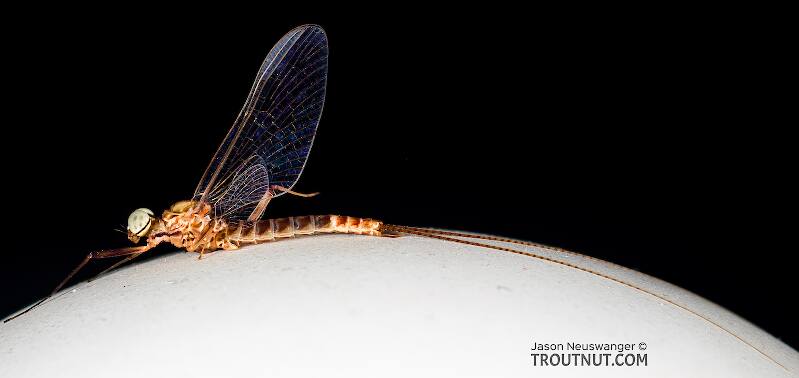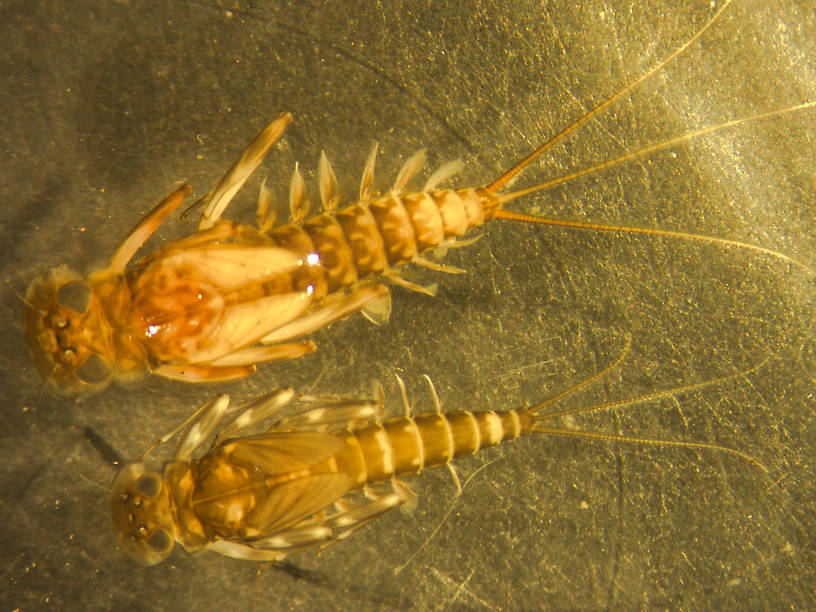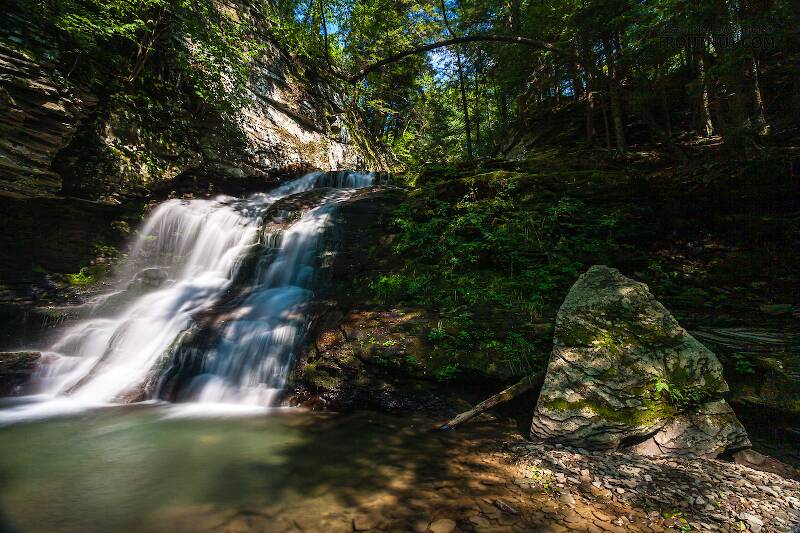
Hex Mayflies
Hexagenia limbata
The famous nocturnal Hex hatch of the Midwest (and a few other lucky locations) stirs to the surface mythically large brown trout that only touch streamers for the rest of the year.
Featured on the forum

This wild-looking little thing completely puzzled me. At first I was thinking beetle or month larva, until I got a look at the pictures on the computer screen. I made a couple of incorrect guesses before entomologist Greg Courtney pointed me in the right direction with Psychodidae. He suggested a possible genus of Thornburghiella, but could not rule out some other members of the tribe Pericomini.

Troutnut is a project started in 2003 by salmonid ecologist Jason "Troutnut" Neuswanger to help anglers and
fly tyers unabashedly embrace the entomological side of the sport. Learn more about Troutnut or
support the project for an enhanced experience here.
Little Slate-Winged Duns
This common name refers to only one species. Click its scientific name to learn more.
Mayfly Species Ecdyonurus criddlei
These are very rarely called Little Slate-Winged Duns.

This one was very puzzling to identify. It's clearly Heptageniidae. It keys pretty easily to couplet 58 in Merritt, Cummins, & Berg 5th Edition, but that's where things get tricky.
58: Male penes distinctly L-shaped; Segment 1 of foretarsi usually 1/3 to 2/3 the length of segment 2
58': Males penes not distinctly L-shaped; Segment 1 of foretarsi usually 1/5 to 1/2 the length of segment 2
The characteristics conflict here, as I'd say the penes ARE L-shaped, but the fore tarsal ratio is less than 1/3. Maybe the weasel word "usually" allows for that, and it's some kind of Stenonema, for which I'm not aware of any records in Montana, let alone western Montana.
Going by the tarsal ratio and assuming it's not Stenonema, everything in couplet 60 points to Afghanurus: contiguous compound eyes, genitalia similar to fig 13.222 in MC&B, and weakly developed basal costal crossveins in the forewings. But I looked up the original descriptions of the three Afghanurus species, and the body sizes (flowersi 5-7 mm, inconspicua 4 mm, joernensis 6-7 mm) are way below this one's 10 mm.
This led me to notice that the closely related Ecdyonurus is not included in the key at all, so I checked the descriptions of those species and found that Ecdyonurus criddlei fits very well: the color of the legs, the markings on the tergites and sternites, the short fore tarsus and ratios of the segments, etc. It was originally described as 7 mm, smaller than the 10 mm body of this specimen, but synonyms have been described with larger sizes including wing lengths up to 11 mm for females for Heptagenia salvini.
This specimen was found with a female nearby, which I think is probably the same species, although it is difficult to be certain.
58: Male penes distinctly L-shaped; Segment 1 of foretarsi usually 1/3 to 2/3 the length of segment 2
58': Males penes not distinctly L-shaped; Segment 1 of foretarsi usually 1/5 to 1/2 the length of segment 2
The characteristics conflict here, as I'd say the penes ARE L-shaped, but the fore tarsal ratio is less than 1/3. Maybe the weasel word "usually" allows for that, and it's some kind of Stenonema, for which I'm not aware of any records in Montana, let alone western Montana.
Going by the tarsal ratio and assuming it's not Stenonema, everything in couplet 60 points to Afghanurus: contiguous compound eyes, genitalia similar to fig 13.222 in MC&B, and weakly developed basal costal crossveins in the forewings. But I looked up the original descriptions of the three Afghanurus species, and the body sizes (flowersi 5-7 mm, inconspicua 4 mm, joernensis 6-7 mm) are way below this one's 10 mm.
This led me to notice that the closely related Ecdyonurus is not included in the key at all, so I checked the descriptions of those species and found that Ecdyonurus criddlei fits very well: the color of the legs, the markings on the tergites and sternites, the short fore tarsus and ratios of the segments, etc. It was originally described as 7 mm, smaller than the 10 mm body of this specimen, but synonyms have been described with larger sizes including wing lengths up to 11 mm for females for Heptagenia salvini.
This specimen was found with a female nearby, which I think is probably the same species, although it is difficult to be certain.

This is an interesting Heptageniid mayfly since in western Montana it is only found in cold lakes, especially those in Glacier National Park.
See 1 more specimen...

